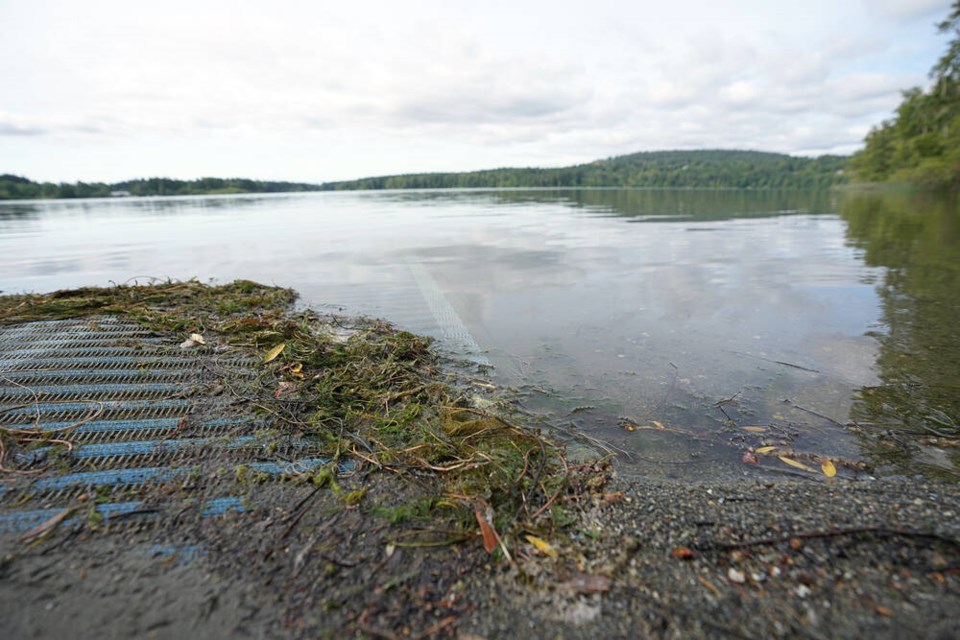Blue-green algae produce nasty, dangerous poisons that rival the weapons of mass destruction we didn’t find in Iraq.

It’s a beautiful July weekend, and you and your dad bod are knee-deep in Elk Lake, keeping an eye on the kids and chowing down on a hamburger. It’s hot sunshine and cool water and school-free children having fun all afternoon.
Sure, it doesn’t smell exactly great out here, but you did eat a lot of coleslaw earlier. And oops, there’s a little bluish-green sand in your wich, so you quick-dunk it in the lake, pop it in your mouth and DIE A TERRIBLE URBAN PICNIC DEATH!
This senseless loss was brought to you by blue-green algae in the water, and the many municipal bylaws prohibiting such a thing as a free lunch. The point of our little vignette is that under the right conditions — such as summer picnics — lakes, ponds and streams in British Columbia develop a dangerous blue-green algae “boom,” which, due to an early typographic error, is more commonly known as a dangerous blue-green algae “bloom.”
Blue-green algae, also known as cyanobacteria, are microscopic organisms that naturally occur in water bodies around the world. They are sort of halfway between plants and animals — teenagers, if you will — and they come in all sorts of colours and sizes, so long as it is blue-green and very small.
What’s the big deal? Well, blue-green algae produce nasty, dangerous poisons — neurotoxins, hepatotoxins and dermatotoxins — that rival the weapons of mass destruction we didn’t find in Iraq. You really don’t want to drink, breathe or touch them, unless you’re into nausea and liver failure.
Blue-green algae have been around since Adam was a lad. Scientists who do not believe in Adam do believe blue-green algae are one of the earliest forms of life. The theory is that, by producing and releasing oxygen over billions of years, blue-green algae helped convert the early Earth’s atmosphere to something breathable that we can safely fly airplanes through.
Normally, blue-green algae are not visible in the water. However, under the right conditions of light, temperature and nutrients, blue-green algae explode in number and form disgusting booms — sorry, blooms — on the water’s surface.
I only say “disgusting” because of the way these mucousy booms — blooms, dang it! — look and smell. Once again, imagine “teenagers,” and you’re pretty much in the right ballpark. To see what I mean, take a look at Blenkinsop Lake in Saanich, or Deer Lake in Burnaby or really, any lake in any town. But maybe don’t take a deep breath until you get home.
These blooms look like gobs of house paint on the surface of water. Most often, it’s blue-green house paint, but sometimes it’s olive green, brown or red. The gobs also come in invisible, which has the advantage of matching everything. That’s right: blue-green algae can be in the water even when you can’t see them.
Watersheds Canada advises that if you see a suspected blue-green algal bloom, you should report it to your local Algae Watch Program administrator. If you do not have a local Algae Watch Program or administrator, well… Watersheds Canada doesn’t have advice about that, so… uh, I guess you are probably a goner.
I should explain that this is a phrase from my youth, which implies a situation where death or failure is imminent or inevitable.
To circumvent being a goner, it is critical that you avoid drinking, swimming, washing dishes, brushing teeth, filling water balloons and/or bathing in the suspect water. Stop looking at it. DON’T EVEN THINK ABOUT WATER. Of course, the advice to avoid water also applies to pets, livestock and visiting relatives from Alberta.
Right now, you’re probably wondering, Dave, how did we get into this situation where water is so dangerous to humans, animals and Albertans?
Unfortunately, it comes down to the usual culprits that affect our world for the worse: climate change (warmer temperatures and invasive species that spread blue-green algae), industrial farming practices (over-use of phosphate and nitrogen fertilizers leading to eutrophication of water) and habitat loss (particularly shoreline wildflowers, trees, shrubs and grasses that create a runoff buffer zone).
My Alberta relatives suspect former Canadian prime minister Justin Trudeau is at least partially responsible, but as they do not yet have the kind of proof required by the International Court of Justice, the principal judicial body of the United Nations.
Speaking of the United Nations, I’m sorry to tell you that the frequency and magnitude of blue-green algal blooms are getting worse across the world. I’m sorry to tell you, because I know at least three-quarters of the news you read is about something getting worse across the world.
But don’t let this get you down, because there are several easy things you and I and our dad bods can do to reverse blue-green algae flare-ups in our part of British Columbia.
For example: Stop global warming and reverse climate change. Easy peasy, lemon-squeezy. You should probably look after this; I’ll take the next one.
“Re-engage” with the province and other stakeholders who play a role in the overall health of the watershed. I think this means meetings and emails. It is the publicly stated next step — I did not make it up — for the Capital Regional District, if new technology installed last year to increase oxygen levels in Elk and Beaver Lakes doesn’t work. Actually, maybe you’d better take this one, too. I already have to go to a lot of meetings.
Finally and most obviously, keep your dad bod safe at home, away from the water. It won’t solve the blue-green algae problem, but it will protect children and Albertans from seeing us in Speedos.